

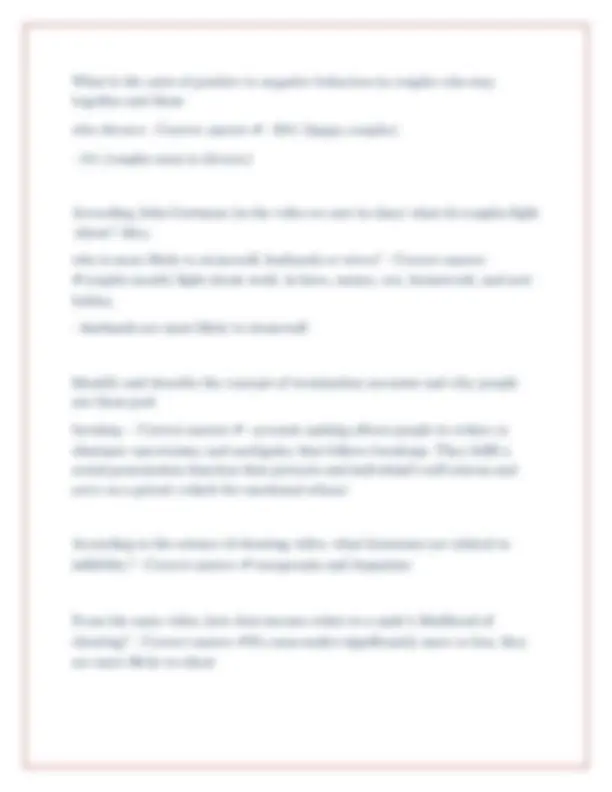
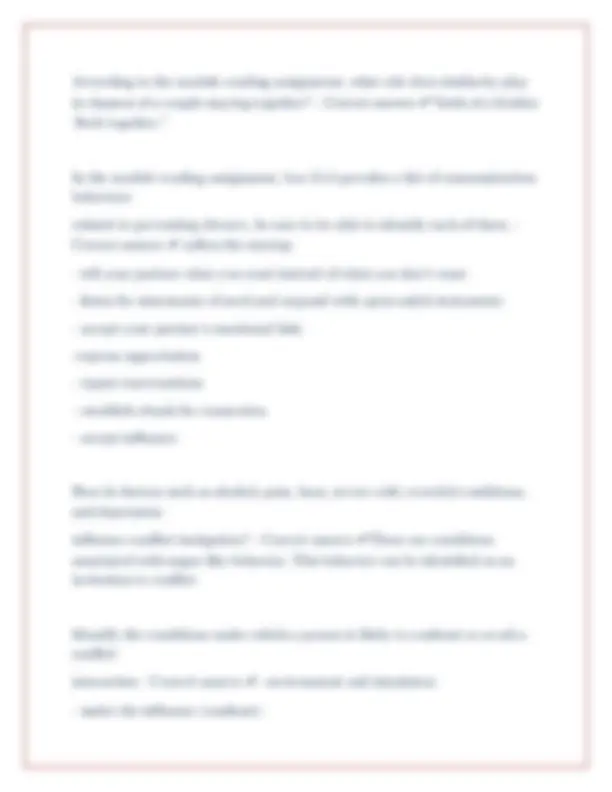
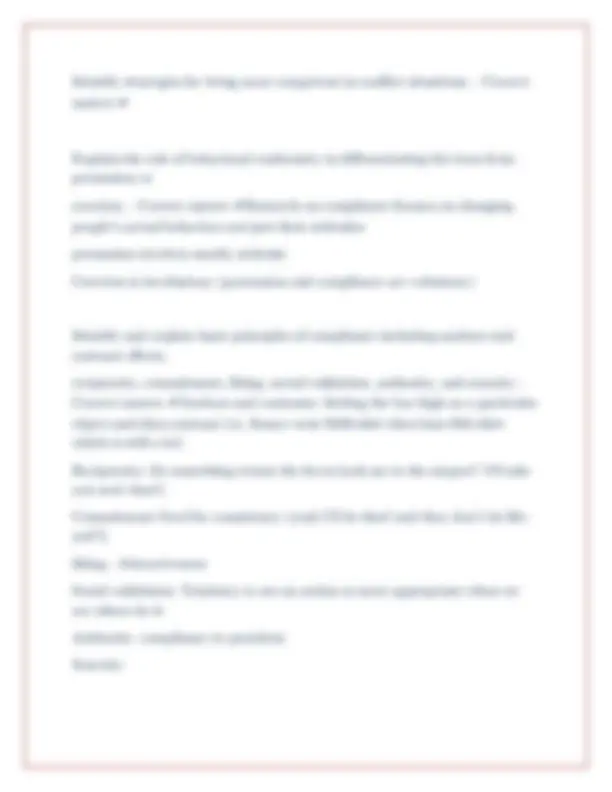

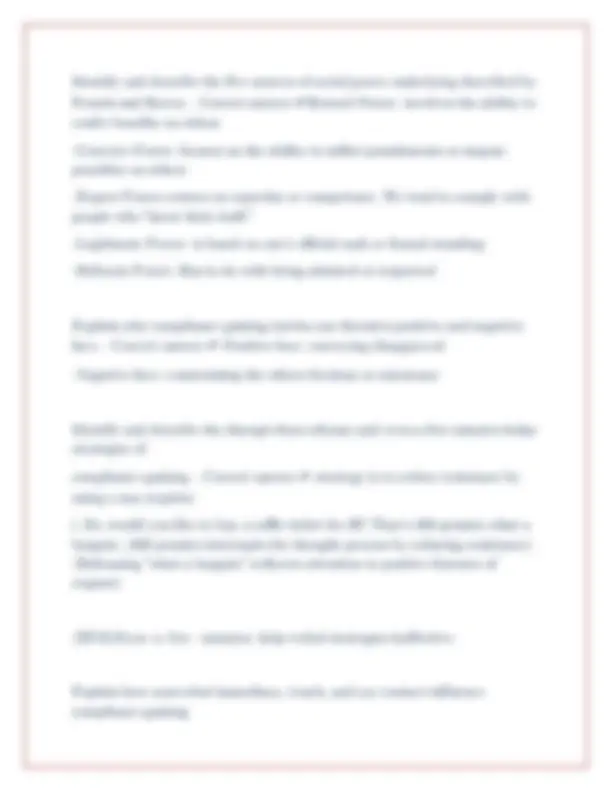
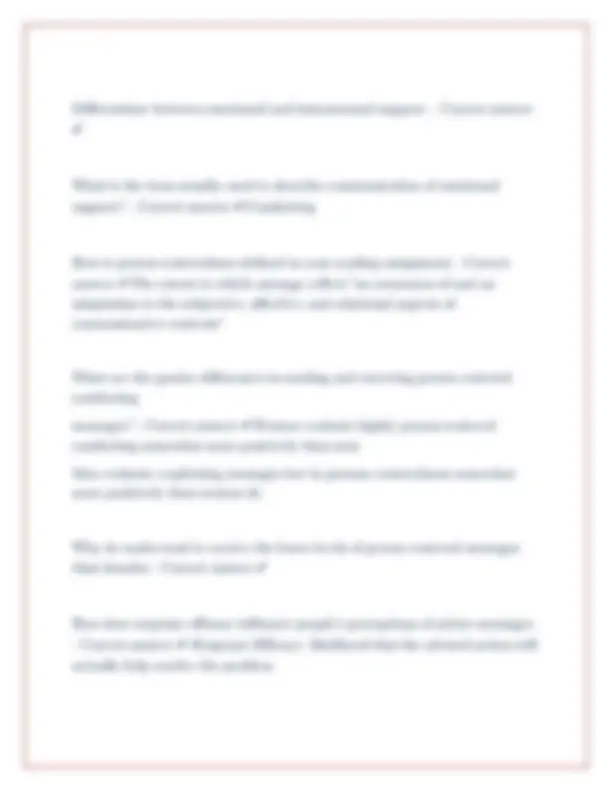
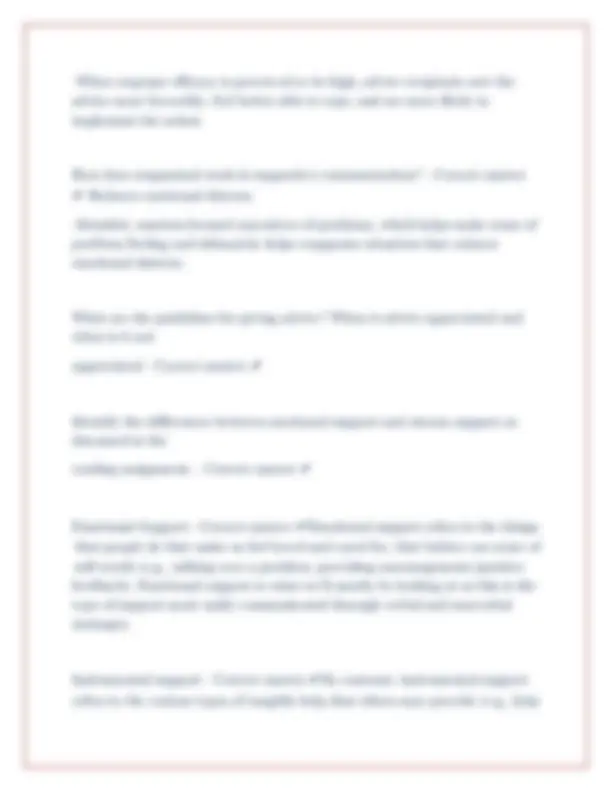



Study with the several resources on Docsity

Earn points by helping other students or get them with a premium plan


Prepare for your exams
Study with the several resources on Docsity

Earn points to download
Earn points by helping other students or get them with a premium plan
Community
Ask the community for help and clear up your study doubts
Discover the best universities in your country according to Docsity users
Free resources
Download our free guides on studying techniques, anxiety management strategies, and thesis advice from Docsity tutors
An overview of key concepts related to relationship dynamics, focusing on conflict resolution and termination. It covers topics such as common complaints leading to breakups, unilateral and bilateral termination strategies, gottman's cascade model of divorce, and communication behaviors associated with distance and dissociation. Additionally, it explores the role of similarity, the impact of various factors on conflict instigation, and strategies for improving conflict management. The document also addresses attributional processes in relationship termination and compliance principles, offering a comprehensive look at the complexities of interpersonal relationships. This material is useful for students studying psychology, sociology, or communication, providing insights into the dynamics of relationships and conflict resolution techniques. (415 characters)
Typology: Exams
1 / 15

This page cannot be seen from the preview
Don't miss anything!










Identify | the | four | general | complaints | people | have | about | their | partner | that | leads | to | break- ups | - | Correct | answer | ✔1. | Faults | with | the | other | person, | too | many | negative | qualities: | lazy, | stupid, | no | fun. |
Bilateral | and | Direct | termination | strategies: | the | blame | game, | the | negotiated | farewell "The | four | horseman | of | the | apocalypse | of | the | marriage" | - | Correct | answer | ✔Criticism, | Defensiveness, | Contempt, | and | Stonewalling What | is | the | divorce | rate | for | first | marriages | and | is | it | higher | or | lower | for | second | marriages? | - | Correct | answer | ✔50% | in | first | marriages | and | divorce | rates | are | higher | in | second | marriage. | 40% | for | individuals | 18-19 | and | 24% | individuals | older | than | 25 Identify | and | describe | Gottman's | Cascade | Model | of | divorce | - | Correct | answer | ✔1. | physiological | responses: | decline | in | marital | satisfaction
What | is | the | ratio | of | positive | to | negative | behaviors | in | couples | who | stay | together | and | those | who | divorce | - | Correct | answer | ✔- | 20:1 | (happy | couples)
According | to | the | module | reading | assignment, | what | role | does | similarity | play | in | chances | of | a | couple | staying | together? | - | Correct | answer | ✔"birds | of | a | feather | flock | together." In | the | module | reading | assignment, | box | 15.3 | provides | a | list | of | communication | behaviors | related | to | preventing | divorce, | be | sure | to | be | able | to | identify | each | of | these. | - | Correct | answer | ✔-soften | the | startup
dentify | the | four | general | conflict | strategies | discussed | in | class | and | the | Canary/Weger | reading | assignment | - | Correct | answer | ✔Created | by | 2 | dimensions: | Activeness | and | agreeableness Negotiation | Direct | fighting | accommodation | indirect | fighting Identify | and | describe | the | four | attributional | facts | related | to | relationship | termination | - | Correct | answer | ✔Attributional | processes | become | activated- | Find | cause | of | conflict | in | others | behaviors Attributional | processes | are | selective- | Personal | interests | (you | think | you | know | what's | going | on | and | behavior | is | justified) Attributional | conflict- | Disagreements | about | the | cause | of | the | behavior | (usually | unresolvable) | Meta | attributions- | Explanations | for | explanations | and | they | create | additional | problems | (excuses | aren't | credible- | illogical | or | unconvincing) How | are | the | attributional | styles | of | distressed | and | nondistressed | couples | different? | - | Correct | answer | ✔Attribute | positive | behaviors | to | situational | causes | that | are | unlikely | to | be | repeated | and | operative | to | one | specific | area | Attribute | negative | behavior | to | a | temporary | state | unstable | over | time | and | it | is | specific | to | one | area
Identify | strategies | for | being | more | competent | in | conflict | situations. | - | Correct | answer | ✔ Explain | the | role | of | behavioral | conformity | in | differentiating | the | term | from | persuasion | or | coercion. | - | Correct | answer | ✔Research | on | compliance | focuses | on | changing | people's | actual | behaviors | not | just | their | attitudes | persuasion | involves | mostly | attitude | Coercion | is | involuntary | (persuasion | and | compliance | are | voluntary) Identify | and | explain | basic | principles | of | compliance | including | anchors | and | contrast | effects, | reciprocity, | commitment, | liking, | social | validation, | authority, | and | scarcity | - | Correct | answer | ✔Anchors | and | contrasts- | Setting | the | bar | high | on | a | particular | object | and | then | contrast | (ex. | Kanye | west | $100 | shirt | then | buys | $50 | shirt | which | is | still | a | lot) Reciprocity- | Do | something | return | the | favor(took | me | to | the | airport? | I'll | take | you | next | time!) Commitment-Need | for | consistency | (yeah | I'll | do | that! | and | they | don't | its | like | wtf?!) liking | - | Attractiveness | Social | validation- | Tendency | to | see | an | action | as | more | appropriate | when | we | see | others | do | it Authority- | compliance | to | president Scarcity-
Identify | and | describe | the | five | sources | of | social | power | underlying | described | by | French | and | Raven. | - | Correct | answer | ✔Reward | Power- | involves | the | ability | to | confer | benefits | on | others -Coercive | Power- | focuses | on | the | ability | to | inflict | punishments | or | impose | penalties | on | others -Expert | Power-centers | on | expertise | or | competence. | We | tend | to | comply | with | people | who | "know | their | stuff." -Legitimate | Power- | is | based | on | one's | official | rank | or | formal | standing -Referent | Power- | Has | to | do | with | being | admired | or | respected Explain | why | compliance | gaining | tactics | can | threaten | positive | and | negative | face. | - | Correct | answer | ✔-Positive | face- | conveying | disapproval -Negative | face- | constraining | the | others | freedom | or | autonomy Identify | and | describe | the | disrupt-then-reframe | and | even-a-few-minutes-helps | strategies | of | compliance | gaining. | - | Correct | answer | ✔-strategy | is | to | reduce | resistance | by | using | a | non | sequitur i. | Ex: | would | you | like | to | buy | a | raffle | ticket | for | 3$? | That's | 300 | pennies | what | a | bargain. | (300 | pennies | interrupts | the | thought | process | by | reducing | resistance) | (Reframing | "what | a | bargain" | redirects | attention | to | positive | features | of | request) (EFM)Even- | a- | few | - | minutes- | help | verbal | strategies | ineffective Explain | how | nonverbal | immediacy, | touch, | and | eye | contact | influence | compliance | gaining |
attempts | - | Correct | answer | ✔touch-tends | to | elicit | a | more | favorable | impression | of | the | requester, | which | translates | into | greater | compliance. | - | eye | contact- | Gaze | is | another | immediacy | behavior | that | has | been | shown | to | facilitate | compliance. i. | Direct | eye | contact | increased | targets | willingness | to | participate | ii. | Works | even | without | a | nonverbal | component Identify | and | describe | the | main | features | of | the | Goals-Plans-Action | theory | of | message | production | - | Correct | answer | ✔Goals: | They | are | future | states | of | affairs | that | an | individual | is | committed | to | achieving | or | maintaining | (Motivate | Plans) | (internal) -Plans: | are | cognitive | representations | of | the | behaviors | that | are | intended | to | enable | goal | attainment | (internal) -Action: | are | the | behaviors | enacted | in | an | effort | to | realize | a | goal. | Whereas | goals | and | plans | are | internal, | actions | are | external How | do | primary | and | secondary | goals | influence | compliance | messages | - | Correct | answer | ✔Primary | goals | are | the | catalysts | for | compliance | gaining, | while | secondary | goals | shape | the | approach | used. Identify | and | describe | each | of | the | RASA | elements | of | Treasure's | acronym | for | effective | listening. | - | Correct | answer | ✔a. | Receive | (pay | attention) b. | Appreciate | (little | noises) c. | Summarize | (so | what | your | saying | is) d. | Ask | (ask | questions | after
Differentiate | between | emotional | and | instrumental | support. | - | Correct | answer | ✔ What | is | the | term | usually | used | to | describe | communication | of | emotional | support? | - | Correct | answer | ✔Comforting How | is | person | centeredness | defined | in | your | reading | assignment | - | Correct | answer | ✔The | extent | to | which | message | reflect | "an | awareness | of | and | an | adaptation | to | the | subjective, | affective, | and | relational | aspects | of | communicative | contexts" What | are | the | gender | differences | in | sending | and | receiving | person | centered | comforting | messages? | - | Correct | answer | ✔Women | evaluate | highly | person-centered | comforting | somewhat | more | positively | than | men | Men | evaluate | comforting | messages | low | in | persons | centeredness | somewhat | more | positively | than | women | do Why | do | males | tend | to | receive | the | lower | levels | of | person | centered | messages | than | females | - | Correct | answer | ✔ How | does | response | efficacy | influence | people's | perceptions | of | advice | messages |
-When | response | efficacy | is | perceived | to | be | high, | advice | recipients | rate | the | advice | more | favorably, | feel | better | able | to | cope, | and | are | more | likely | to | implement | the | action How | does | reappraisal | work | in | supportive | communication? | - | Correct | answer | ✔-Reduces | emotional | distress -Detailed, | emotion | focused | narratives | of | problems, | which | helps | make | sense | of | problem/feeling | and | ultimately | helps | reappraise | situation | that | reduces | emotional | distress. What | are | the | guidelines | for | giving | advice? | When | is | advice | appreciated | and | when | is | it | not | appreciated | - | Correct | answer | ✔ Identify | the | differences | between | emotional | support | and | esteem | support | as | discussed | in | the | reading | assignment. | - | Correct | answer | ✔ Emotional | Support | - | Correct | answer | ✔Emotional | support | refers | to | the | things | that | people | do | that | make | us | feel | loved | and | cared | for, | that | bolster | our | sense | of | self-worth | (e.g., | talking | over | a | problem, | providing | encouragement/positive | feedback). | Emotional | support | is | what | we'll | mostly | be | looking | at | as | this | is | the | type | of | support | most | easily | communicated | through | verbal | and | nonverbal | messages. Instrumental | support | - | Correct | answer | ✔By | contrast, | instrumental | support | refers | to | the | various | types | of | tangible | help | that | others | may | provide | (e.g., | help